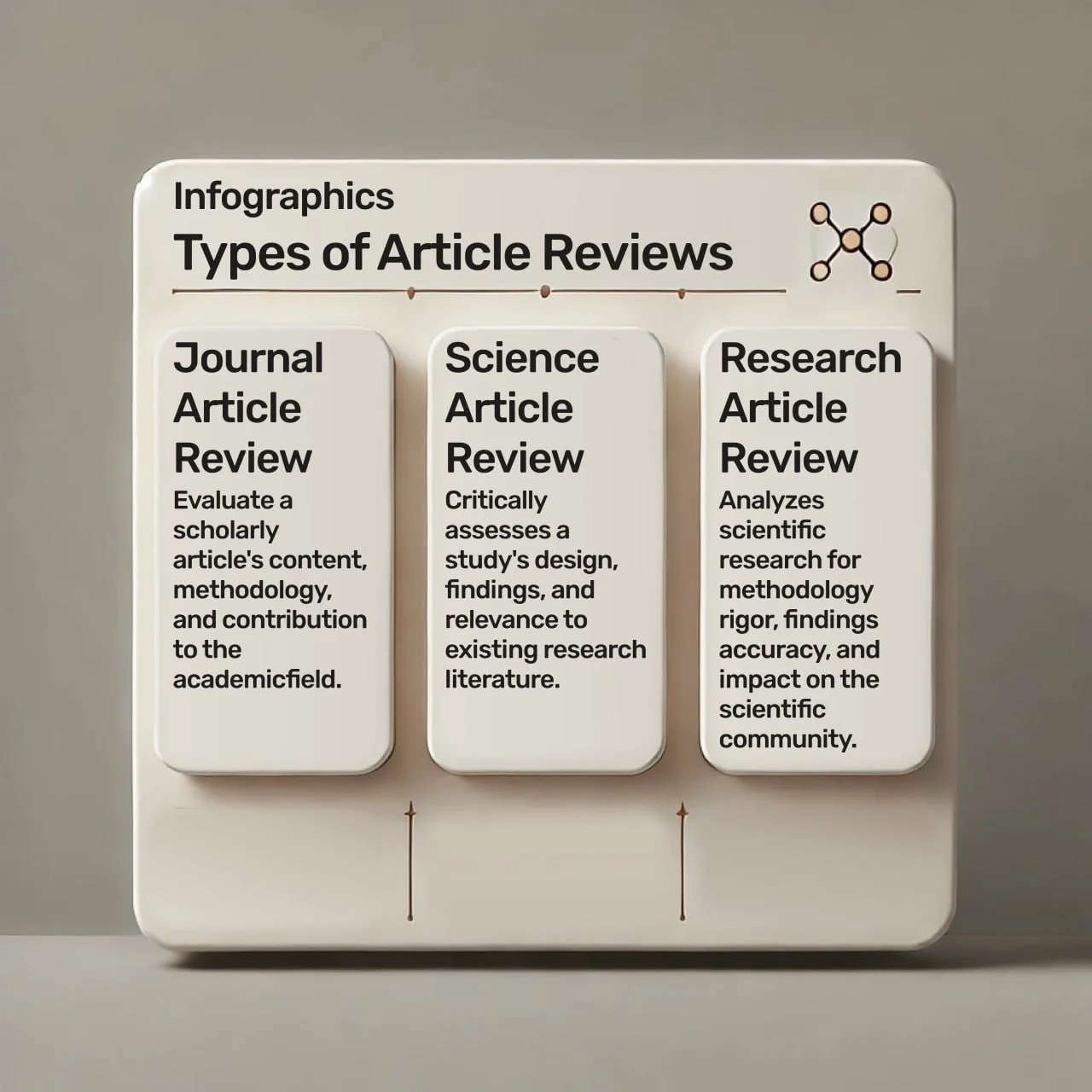How to Write an Article Review: Writing Steps & Useful Tips
When required to write an article review, it may appear to be a challenge initially. This article guide is here to help you know what this paper is, the various types, and how to develop an effective article review. We will give you simple guidelines and tips that you can apply to improve your review skills. So, do you want to know how to write a review paper? Check this academic guide.
What is an Article Review
According to the University of Waterloo, an article review is a process of critically analyzing and evaluating the content of an article. This assignment demands that you read the article carefully, comprehend its thesis, points, and implications, and then construct a comprehensive critical analysis. The objective is to review the contributions made by the article to the topic of discussion and point out the strengths and weaknesses of the article.
Types of Article Reviews
There are various article review types, each with its direction and structure. It is important to know the distinctions they have so you will be able to write your task with a more definite angle.
Journal Article Review
A journal article review critically assesses a scholarly article published in an academic journal. Such reviews summarize the article's content and critically evaluate the research methodology, findings, and contribution to the field. The article's relevance, the quality of its research, and the direction for future research are all things to consider. Journal article reviews are a great way to get involved in the topic and learn more about the workings of scholarly research.
Research Article Review
A research article review involves analyzing and critiquing a piece of knowledge. This entails an in-depth controversial analysis of why the research was undertaken, what questions were researched to help obtain information for developing a new product, how this study carries out its investigations, and obtaining results that form conclusions. Here are some key elements:
- Objective: Understand the article's aim and significance.
- Methodology: Evaluate the research methods used.
- Findings: Discuss the results and their implications.
- Conclusion: Consider the study's conclusions and their relevance.
Once you can determine the significant points mentioned above, it is pivotal to self-conduct a criticism of methods and discuss the impacts of results. These article reviews make you a good analyzer and help establish a better understanding and insight into research processes and their consequences to the various areas.
Science Article Review
In a scientific article review, your focus is on the methodology of a particular study, its results, and its relation to current research. It means it encompasses an appraisal of the article's scientific quality, design flaws in the experiment conducted, data credibility tainted by certain imperfections, and conclusions drawn from a body. Such article reviews go to the level of producing an insight into scientific inquiry and help you be more critical when dealing with the storehouse of literature.
Article Review Format: Main Writing Nuances
Your reader should be able to parse your article review quickly and efficiently, fastening upon its constructive criticisms. The format of its construction hence plays an important part in assuring this efficiency for effective critical communication is provided.
Using the APA Format
In an APA format article review, the specifications for citation requirements, references, and content structure should be thoroughly followed. A title page should contain your first and last name, your affiliated institution, and what book is being reviewed. An abstract that provides a short version of the major points of your article reviews needs to be written. Remember to separate your arguments using double spaces and use a standard font, for instance., 12 pt Times New Roman.
Using MLA Format
In MLA style, your article review should start with the author's name in the upper left corner, followed by the instructor's name, course, and date. Century and being the title of a given book, it should be placed at the center on just one line lower than that, including all headings and subheadings with each chapter. Give details in the body of your review, such as the author's last name and page, which are used for citation, whereas all other sources listed at the end are referred to in this section. ML Studies require ten spaces, a legible font such as 12 Times New Roman, and an inch margin. And check an example of an article review if you need some sort of guidance!
Article Review Outline: Top-Tier Tips
An outline is an important step in arranging your ideas and making sure that there will be a logical structure to follow. A good outline works as a map that takes you through the review process in every step. It ensures that your critique is in a logical outline, so all points of it are covered. So, here are tips to consider.
Running Head
The running head is a short version of the title that appears at the top of each page. It should be concise yet descriptive. Here is an article review example that explains basic paper features:
- Keep it under 50 characters.
- Capitalize all major words.
- Please place it in the header, aligned to the left.
- Ensure it's consistent across all pages.
The heading gives the readers a means of identification, more so when printed or shown on a digital display, among many other documents. This running head will guide navigation, meaning that regardless of what page the reader is on in your review, they can always see it captioned.
Summary Page
The summary page should be the section where you present a brief outline of what an article reviewed entails, summarizing its major points, findings, and conclusions. This part is brief; the area should focus on this article's core facts: you are not involved with self-made masks. But you can always reach us if you need professional paper writing services.
Title Page
The title page is your first encounter with the review, and you need to include details such as the name of this review, your personal information (your full surname), and institutional affiliation. You format it using the citation style formatting on this page.
Introduction
In the introduction of your article review, prepare for critique. Start with a captivating introduction that will capture the reader's attention before going into detail. Whether the article is designed for researchers, a broader academic audience, or general readers, note its title, author(s), and topic it dwells upon. Besides, you can always pay for essay online (or an article review)! Just reach us and ask for help!
Body
The body of your article review is where you dive into the analysis. Here are things to consider:
- Provide a concise overview of the article's main points.
- Analyze the article's arguments, methodology, and findings.
- Support your critique with examples from the article.
- Compare the article's contributions to existing research.
In this section, you should interact deeply with the article's content, highlighting its merits and shortcomings. Valid backing of your critique with sound rationales and evidence from the source article itself, when necessary as well must be done.
Works Cited/References
This section is important since it allows you to cite sources that should be listed here after use. The second section changes depending on the citation style that you are using, whether APA, MLA, etc. Make sure that each citation is correct and meets all the format requirements. Besides, do not hesitate to say, "Do my homework." We are here to assist.
Tables and Figure Legends (if instructed by the professor)
If your professor instructs you to include tables and figure legends, this section should present data and visuals that support your critique or highlight significant aspects of the article reviewed.
- Tables: Summarize data or compare information relevant to your review.
- Figure Legends: Provide clear descriptions for any figures, graphs, or images included, explaining their significance.
This addition can enrich your review by visualizing important points or information regarding the article. At the same time, it is also required to make sure that each table and every figure has been labeled correctly within your paper on review.
An Example of an Article Review Process
A structured approach to writing the article review starts with an in-depth reading of the source. It ends with a high-quality critique that effectively enriches the reader's knowledge. Just check these steps!
Come up with a Title
It is a big step in writing an article review, where you must develop the title for your critique. It is because the title should reflect what type of content a particular review has while also being catchy for readers interested in that kind of topic. Try to add some important points of your writing or the main idea from the article in its title to make it possible for readers to think you are going in his direction.
Cite the Article
You must include the complete citation at the beginning of your review, based on the specific requirement for a Citation Style (APA /MLA, etc.) as defined by instructors. It incorporates authorship information, article title, journal name, and publication year. If more than one author's name is used, both personal and institutional initial/last names should be provided, ending first followed by (forthwith; abbrev.) full surname or without any middle digraph characters.
Identify the Article
Annotating the article is more than citing it; you need to provide an introduction that will create a context background for your readers. Explain the context for writing, after which discuss briefly the publication date and credentials of the author used and for what reason this article has been selected.
Write the Introduction
The introduction of your article review should hook the reader and provide a roadmap for what's ahead.
- Engage the reader with an interesting opening.
- Present the article: include the title, author, and a brief description.
- State the purpose of your review.
- Outline what the reader can expect in the following sections.
Here, you intend to provide a starting point for building the background for critiquing this article by explaining its lore publication stage with a core thesis and relevance. An introduction should accurately conclude with a thesis statement, which will be the foundation of your critical view of the article.
Summarize the Article
To sum up, the article simplifies its arguments and information in a summary. Emphasize what the article is trying to achieve, how it sets out to answer its research questions, and which methodology was used in gathering data and insights about them; highlight outcomes reached by a given piece of writing's role should be played, too.
Write Your Critique
The underpinning of the article review is the process of penning your critique. In such a case, it is necessary to criticize the views and approaches used in the article and the evidence provided. Here is what you should do:
- Assess the strengths and weaknesses of the article.
- Discuss the article's contributions to the field and its overall credibility.
- Evaluate the evidence presented and the conclusions drawn.
- Consider the article's impact on future research, policy, or practice.
Your review should be objective, appreciating the article's merits and noting weaknesses as may exist. Both the evaluation and sources give examples that support your judgment.
Conclude the Article Review
The final section of your article review should include a highlighting coverage and reflection on the five main critical points that were brought up, along with restating what field had this particular essay's significance. Consider the significance of your critique for a given field and its implications for applied theory.
Proofreading is a Must!
Revision and proofreading of the article review reduce ambiguity, bolster consistency in writing style, improve organization within sentences and paragraphs, and enhance its academic quality. Check for spelling, loss of grammar, and omissions in punctuation. Check your citations and references for validity. Stick to reasoning that is consistent and empirical. Let the inspiration be with you!







Comments (0)
Thank you for your comment! 🌟
It has been submitted and is awaiting moderation. Stay tuned—it will be visible soon!